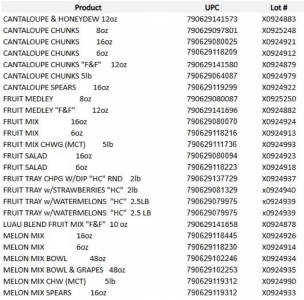
When it comes to foodborne illness, age isn't just a number. The recent FDA recall of 24 fresh-cut fruit products due to potential Listeria contamination carries particularly serious implications for Americans over 65. While younger adults might brush off food poisoning as an inconvenience, more than half of all Listeria infections occur in people 65 and older, making this recall a serious matter for many seniors.
The contaminated products were distributed by Wholesale Produce Supply and were sold under the "Harvest Cuts" and "Fresh & Finest" brands.
But before you check your refrigerator, you should understand why this particular bacteria poses such a grave threat to older adults.
Why listeria is especially dangerous as you age
Unlike many foodborne pathogens that cause only short-term discomfort, Listeria monocytogenes is a serious threat to older adults.
People aged 65 and older are significantly more likely than younger individuals to contract a Listeria infection.
The outcomes can be severe and even life-threatening. The statistics paint a sobering picture.
The CDC ranks Listeria as one of the leading causes of death from foodborne illness in the United States.
While the number of infections is lower than for some other pathogens, the risk of serious complications is much higher—especially for seniors.
In most cases involving older adults, hospitalization is required. And tragically, many of these cases result in death.
"Listeria is especially harmful to people aged 65 or older, women who are pregnant, or people with weakened immune systems"
Several factors make seniors more vulnerable. As we age, our immune systems naturally weaken, making it harder to fight off infections.
This reduced immune response can make it more difficult to recognize and eliminate harmful germs like Listeria.
Older adults also tend to have less stomach acid, which normally helps kill bacteria that enter the body through food.
Many seniors take medications that can further compromise the immune system.
Chronic health conditions such as diabetes or heart disease can also increase the risk of serious illness.
Also read: Salmonella outbreak prompts expanded frozen vegetable recall
What makes this recall particularly concerning
The contaminated products were distributed by Wholesale Produce Supply to Nebraska, North Dakota, and Wisconsin.
They were sold under the "Harvest Cuts" and "Fresh & Finest" brands.
The recall includes various fresh-cut fruit combinations, making it essential to check all your recent fruit purchases—not just plain cantaloupe.
Unlike many bacteria that die in cold temperatures, Listeria can survive and even grow under refrigeration.
This means contaminated fruit could still be dangerous, even if it's been stored properly in your refrigerator for days or weeks.
Listeria's survival skills
Listeria can survive in the refrigerator and can easily spread to other foods and surfaces. This hardy bacteria can live on cutting boards, in refrigerator drawers, and even in freezers, potentially contaminating other foods long after the original source is gone.
The recalled products were sold in both traditional plastic clamshell containers and mixed containers with other fruits.
This increases the potential for cross-contamination.

Recognizing the symptoms can save your life
Symptoms usually start within 2 weeks after eating food contaminated with Listeria, but they may begin as early as the same day or as late as 10 weeks after exposure.
This extended timeframe means you might not immediately connect your illness to something you ate weeks or even months ago.
Early symptoms often mimic the flu: fever, muscle aches, nausea, and fatigue.
However, for seniors and other vulnerable populations, the infection can progress to more serious invasive listeriosis.
Invasive listeriosis affects the nervous system and can cause symptoms like headache, stiff neck, confusion, loss of balance, and convulsions.
Don't wait to see if symptoms improve.
Get emergency care if you experience any of the following: a high fever, severe headache, or stiff neck.
These could be signs of a life-threatening complication from listeria infection called bacterial meningitis.
Also read: Massive recall: 58 million pounds of corn dogs pulled from freezers nationwide
What you need to do right now
If you have any fresh-cut cantaloupe or mixed fruit containers from the recalled brands, don't taste them to see if they seem fine.
Throw them away immediately or return them to the store for a full refund.
But disposal is just the first step.
The real work begins with decontamination.
Clean your refrigerator, containers, and surfaces that may have touched the affected foods.
Listeria can survive in the refrigerator and can easily spread to other foods and surfaces.
Pay special attention to areas where the fruit package might have sat or dripped.
Don't forget to clean your hands thoroughly after handling any potentially contaminated items.
Recent outbreaks show this is an ongoing concern
This cantaloupe recall comes on the heels of other serious Listeria outbreaks in 2025.
Earlier this year, supplement shakes distributed to long-term care facilities were linked to 38 infections and 12 deaths across 21 states.
The majority of victims were seniors, highlighting the ongoing vulnerability of older adults to this dangerous bacteria.
Did you know?
Did you know?
Every year in the United States, an estimated 1,250 people get sick from Listeria, but the impact isn't evenly distributed. The elderly bear a disproportionate burden, with higher infection rates, more severe symptoms, and tragic outcomes that could often be prevented with proper food safety practices.
These repeated outbreaks underscore the importance of staying vigilant about food recalls and maintaining rigorous food safety practices, especially as we age.
Also read: Kroger issues recall on 6 frozen foods in 17 States—check your freezer now!
Protecting yourself going forward
While you can't eliminate all risk, you can significantly reduce your chances of Listeria infection with smart shopping and storage practices.
Choose whole fruits over pre-cut when possible. If you do buy pre-cut produce, consume it quickly and store it properly.
When handling any fresh produce, wash your hands before and after.
Use clean cutting boards and knives.
Store cut fruits in the refrigerator for no more than a few days.
If something looks, smells, or tastes off, trust your instincts and throw it away.
Essential steps for seniors during listeria recalls
- Dispose of recalled products immediately—don't taste test
- Clean refrigerator thoroughly with bleach solution
- Monitor symptoms for up to 10 weeks after potential exposure
- Seek emergency care for high fever, severe headache, or stiff neck
- Call your doctor if you consumed recalled products, even without symptoms
Remember to sign up for FDA recall alerts here.
Don't hesitate to call your healthcare provider if you have any concerns about potential exposure.
With Listeria, it's always better to be overly cautious than to risk serious complications.
What This Means For You
For questions about this specific recall, contact Wholesale Produce Supply at (612) 378-2025. Your health and safety are worth that extra phone call.
Have you signed up for recall alerts, or do you have tips for staying on top of food safety news? Share your thoughts in the comments below—your experience might help a fellow reader stay safe.
Read next:
- Are these in your pantry? FDA issues urgent warning amid widespread sweetener recall
- Recall alert: Trader Joe’s product pulled over missed safety inspection
- Check your fridge: New sausage recall issued across three states
Original Article
https://www.allrecipes.com/cantaloupe-recall-listeria-september-2025-11821358
People at Increased Risk for Listeria Infection | Listeria Infection | CDC
Cited text: More than half of all Listeria infections occur among people 65 years and older.
Excerpt: more than half of all Listeria infections occur in people 65 and older
https://www.cdc.gov/listeria/risk-factors/index.html
Adults 65 and Older: An At-Risk Population, but Why? | Food Safety and Inspection Service
Cited text: In addition, adults who are 65 years and older are 4 times more likely than other people in the United States to get Listeria infections.
Excerpt: Adults who are 65 years and older are 4 times more likely than other people in the United States to get Listeria infections
https://www.fsis.usda.gov/news-events/news-press-releases/adults-65-and-older-risk-population-why
Adults 65 and Older: An At-Risk Population, but Why? | Food Safety and Inspection Service
Cited text: CDC estimates Listeria is the third leading cause of death from food poisoning in the United States. An estimated 1,600 people get sick from Listeria ...
Excerpt: CDC estimates Listeria is the third leading cause of death from food poisoning in the United States.
https://www.fsis.usda.gov/news-events/news-press-releases/adults-65-and-older-risk-population-why
People at Increased Risk for Listeria Infection | Listeria Infection | CDC
Cited text: Older adults with Listeria infection almost always have to be hospitalized. Sadly, 1 in 6 older adults with this infection die.
Excerpt: Older adults with Listeria infection almost always have to be hospitalized. Sadly, 1 in 6 older adults with this infection die
https://www.cdc.gov/listeria/risk-factors/index.html
People at Increased Risk for Listeria Infection | Listeria Infection | CDC
Cited text: As you get older, your immune system has a harder time recognizing and getting rid of harmful germs, including Listeria. You also have less stomach ac...
Excerpt: As you get older, your immune system has a harder time recognizing and getting rid of harmful germs, including Listeria.
https://www.cdc.gov/listeria/risk-factors/index.html
Listeria (Listeriosis) | FDA
Cited text: It can survive and grow even under refrigeration.
Excerpt: Listeria can survive and grow even under refrigeration
https://www.fda.gov/food/foodborne-pathogens/listeria-listeriosis
Listeria (Listeriosis) | FDA
Cited text: It can survive and grow even under refrigeration.
Excerpt: Listeria can survive and grow even under refrigeration
https://www.fda.gov/food/foodborne-pathogens/listeria-listeriosis
CDC expands Listeria outbreak to include more prepared meals | CDC Newsroom
Cited text: Listeria can survive in the refrigerator and can easily spread to other foods and surfaces.
Excerpt: Listeria can survive in the refrigerator and can easily spread to other foods and surfaces
https://www.cdc.gov/media/releases/...ert-to-include-additional-prepared-foods.html
CDC warns of Listeria outbreak linked to supplement shakes distributed in long-term care facilities | CDC Newsroom
Cited text: Symptoms usually start within 2 weeks after eating food contaminated with Listeria but may start as early as the same day or as late as 10 weeks after...
Excerpt: Symptoms usually start within 2 weeks after eating food contaminated with Listeria but may start as early as the same day or as late as 10 weeks after
https://www.cdc.gov/media/releases/2025/2025-supplement-shakes-listeria-outbreak.html
Listeria infection-Listeria infection - Symptoms & causes - Mayo Clinic
Cited text: Get emergency care if you have any of the following: A high fever. Very bad headache. Stiff neck.
Excerpt: Get emergency care if you have any of the following: A high fever. Very bad headache.
https://www.mayoclinic.org/diseases-conditions/listeria-infection/symptoms-causes/syc-20355269
Listeria infection-Listeria infection - Symptoms & causes - Mayo Clinic
Cited text: These could be symptoms of a life-threatening condition that can happen with a listeria infection, called bacterial meningitis.
Excerpt: Get emergency care if you have any of the following: A high fever. Very bad headache.
https://www.mayoclinic.org/diseases-conditions/listeria-infection/symptoms-causes/syc-20355269
CDC expands Listeria outbreak to include more prepared meals | CDC Newsroom
Cited text: Clean your refrigerator, containers, and surfaces that may have touched the affected foods. Listeria can survive in the refrigerator and can easily sp...
Excerpt: Clean your refrigerator, containers, and surfaces that may have touched the affected foods.
https://www.cdc.gov/media/releases/...ert-to-include-additional-prepared-foods.html
People at Increased Risk for Listeria Infection | Listeria Infection | CDC
Cited text: Every year in the United States, an estimated 1,250 people get sick from Listeria.
Excerpt: Every year in the United States, an estimated 1,250 people get sick from Listeria
https://www.cdc.gov/listeria/risk-factors/index.html






